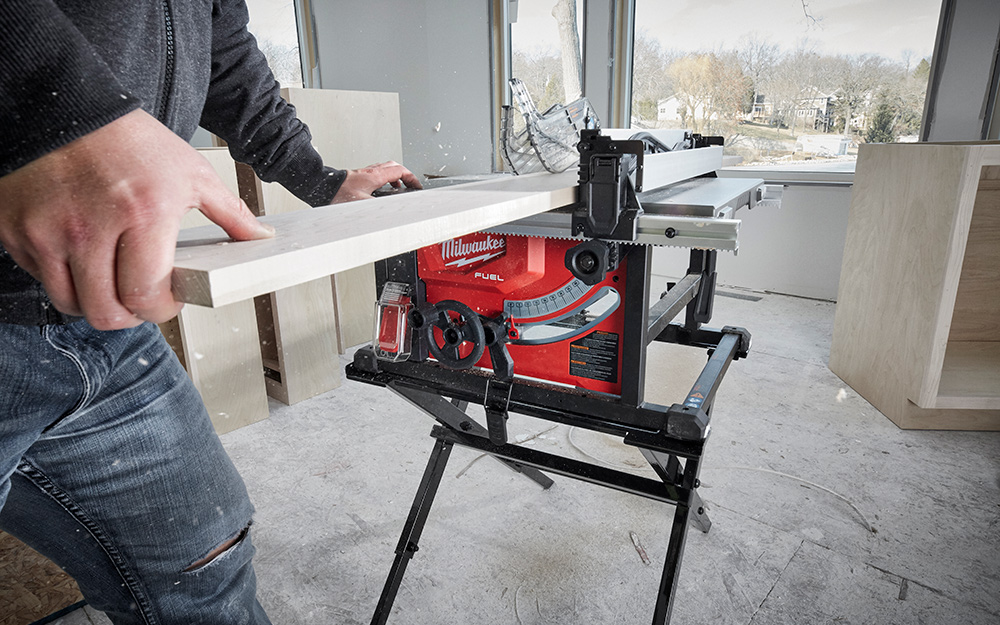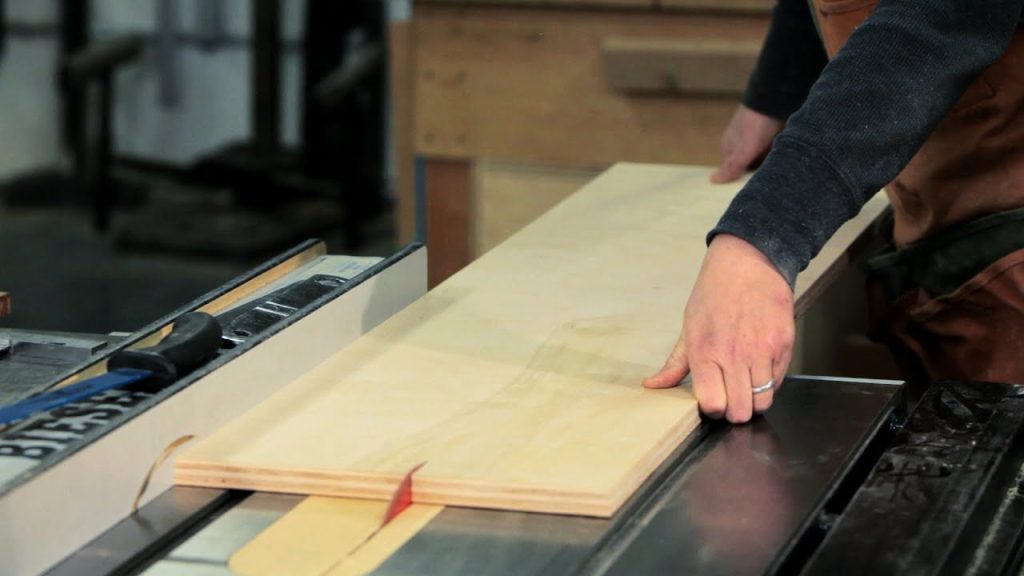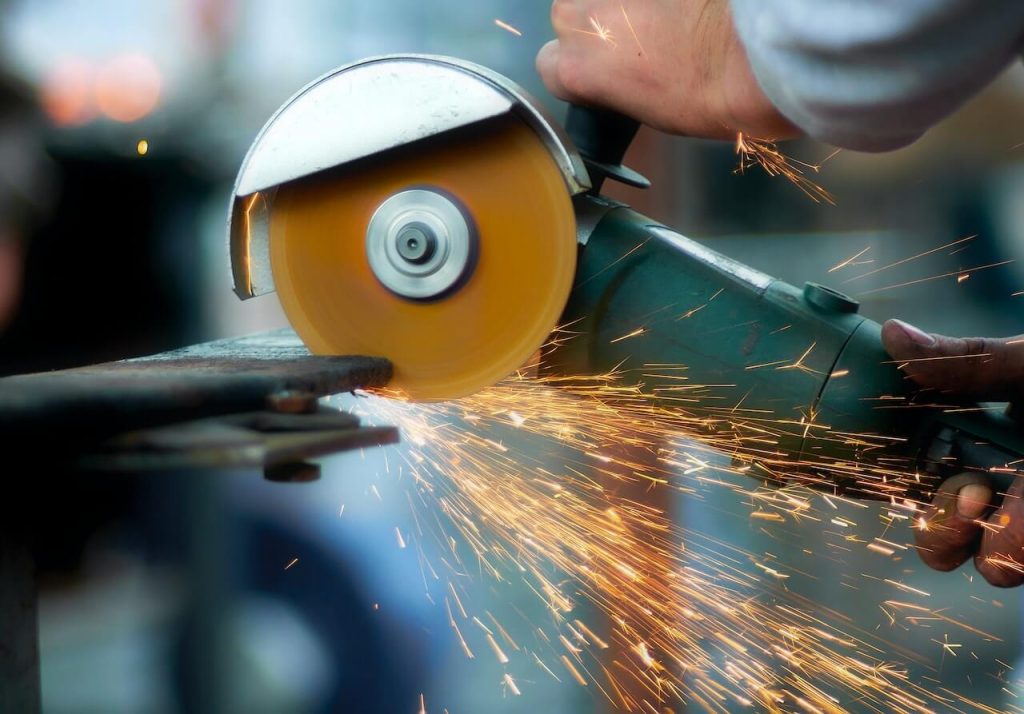Using a table saw can be tricky if you’ve never done it before, but once you get the hang of it, it’s actually quite easy. The first thing you need to do is make sure that the saw is properly set up and that the blade is sharp. Next, you need to measure the wood that you’re going to be cutting and mark it with a pencil.
Then, you need to set the fence so that it’s in line with your mark. Finally, you can turn on the saw and start cutting! Just remember to go slowly at first and keep your hands away from the blade.
- Read the instruction manual that came with your table saw before using it
- Place the table saw on a level surface and plug it into an outlet
- Turn on the table saw and let it come to full speed before using it
- Adjust the blade of the saw to the desired height and bevel angle before making any cuts
- Hold the piece of wood you are cutting firmly against the fence of the saw while making sure your fingers are well away from the blade
- Push the wood slowly and evenly through the blade, letting the weight of the wood do most of the work for you
Using A Table Saw For The First Time | Beginner
What are 3 Safety Rules for a Table Saw?
1. Always use a push stick when feeding material into the blade. 2. Keep your hands well away from the blade while it is in operation. 3. Use a saw guard and riving knife to help prevent kickback accidents.
Which Way Do You Push Wood Through a Table Saw?
Assuming you’re talking about a standard 10″ table saw, the wood should be fed into the blade from the right side of the table. The blade should be spinning clockwise when viewed from above, so you would push the wood through with your right hand while gripping it with your left hand behind the piece. Always use a push stick or other pushing device to avoid getting your fingers too close to the blade.
What Do You Really Use a Table Saw For?
A table saw can be one of the most versatile tools in your shop. With the right blade, a table saw can make rip cuts, crosscuts, miter cuts, and even dadoes and rabbets. By changing the blade, you can cut through just about any material, including wood, plastic, metal, and tile.
Table saws typically have two types of blades: carbide-tipped and high-speed steel (HSS). Carbide-tipped blades are more expensive but stay sharp longer and can handle tougher materials. HSS blades are less expensive but require more frequent replacement.
When choosing a table saw blade, always match the blade to the material you’ll be cutting most often. For general woodworking applications, we recommend a 40-tooth carbide-tipped or 50-tooth HSS combination blade. These all-purpose blades provide good results on both hardwoods and softwoods.
For specific tasks like cutting plywood or making precise miters or crosscuts in hardwood stock ,you may want to invest in a specialty blade like an 80-tooth triple chip grind (TCG) carbide tippedblade designed for cutting laminate flooring , melamine panels ,and veneered plywood .
How Do You Cut Small Pieces of Wood With a Table Saw?
If you need to cut small pieces of wood, a table saw is the best tool for the job. Here are some tips on how to make accurate cuts:
1. Mark your cutting lines with a pencil or chalk.
This will help you keep track of where you need to make your cuts.
2. Use a push stick or other safety device to keep your hands away from the blade while cutting.
3. Set the fence on the table saw so that it is aligned with the marks on your piece of wood.
This will ensure that your cuts are straight and accurate.
4. Slowly feed the wood into the blade, keeping it level with the table surface. Let the weight of the wood do most of the work – don’t force it through too quickly or unevenly.

Credit: www.homedepot.com
How to Use a Table Saw to Rip Boards
If you’re looking to rip boards on a table saw, there are a few things you need to know. First, you need to adjust the blade of the saw to be at a 45 degree angle. Next, you’ll want to use a push stick to help guide the board as you cut it.
Finally, make sure that your hands are never in line with the blade while cutting – if they are, serious injury could occur.
Now that you know the basics, let’s get started. To rip a board, start by placing it against the fence of the table saw so that the edge is flush with the blade.
Then, holding onto the end of the board with your non-dominant hand, use your dominant hand to push the board through the blade. As you do this, keep an eye on your fingers and make sure they aren’t getting too close to the spinning blade.
Once you’ve made it all the way through, take a look at your cut – it should be clean and even.
If not, don’t worry! Just adjust your fence slightly and try again until you get it just right. With a little practice, anyone can master using a table saw to rip boards like a pro!
How to Use a Table Saw Safely
Most woodworkers will tell you that the table saw is the heart of their shop. And with good reason- a table saw can do everything from rip lumber to cross cut boards, and even make decorative cuts for projects. But as versatile and handy as a table saw can be, it’s also one of the most dangerous tools in your shop if used improperly.
That’s why today we’re going over how to use a table saw safely, so you can avoid any accidents or injuries while working.
First things first- before you even turn on your table saw, take a minute to assess the area around it and make sure there’s nothing that could potentially get caught in the blade. This includes loose clothing, cords, other tools, or anything else that could become entangled.
Once you’ve cleared the area, it’s time to look at your own safety. Always wear close-fitting clothes when working with a table saw- no baggy sleeves or pants that could get caught up in the blade. In addition, wear gloves to help protect your hands from kicked-back debris or accidental contact with the blade itself.
And finally, always use eye protection when working with any power tool- flying debris can cause serious eye injury if not properly protected against.
Now that you’re all set up and ready to go, let’s talk about proper technique for using a table saw. When making rip cuts (cuts along the length of a board), always use a push stick or similar device to feed the workpiece into the blade; never try to push it through by hand.
For cross cuts (cuts perpendicular to the grain of the wood), position your workpiece so that its end is supported by either an outfeed stand or another person before making the cut; this will help prevent kickback should the piece bind on the blade mid-cut. When cutting curves or other intricate shapes, use a jigsaw or bandsaw instead of risking kickback or losing control of your workpiece entirely;table saws are not designed for these types of cuts and trying to force them can be very dangerous.
Finally, when you’re finished making all your cuts, always turn offthe powerto yourtable sawbefore removing anycut piecesfromthebladearea; thiswill help preventanyaccidentsshouldyou reachacross withoutrealizingthebladewas stillspinning underneath .
How to Use a Table Saw to Cut Plywood
In order to make clean, precise cuts in plywood, you will need to use a table saw. A table saw is a powerful tool that can easily cut through thick pieces of plywood. However, before using a table saw, it is important to read the instruction manual and understand how to safely operate the machine.
Here are some tips on how to use a table saw to cut plywood:
1. Before cutting any piece of wood, always measure and mark the desired dimensions with a pencil. This will help you avoid making any mistakes while cutting.
2. When setting up your table saw, be sure to adjust the blade height so that it is level with the surface of the plywood. The blade should also be slightly tilted towards the back of thesaw so that it cuts cleanly through the entire thickness of the wood.
3. To make straight cuts, clamp a guide rail onto the plywood before beginning to cut. This will help you keep the blade aligned and prevent it from veering off course. For curved or irregular cuts, you can use a jigsaw instead of a table saw.
4 . Always wear safety goggles when using a table saw (or any other power tools). Keep your fingers well away from the path ofthe blade as it spins at high speeds – if they come into contact withthe blade, serious injuries can occur . Also , be aware of flying debris – chips and dust can cause eye damage if they hit you in the face . If possible , work ina well-ventilated area to avoid inhaling too much dust .
5 . Once you have finished making your cuts , unpluggedthe power cord from the outlet and wait forthe blade to come to a complete stop before removing any piecesof wood fromthetable .
How Does a Table Saw Work
If you’re new to woodworking, or even if you’ve been doing it for a while, you might be wondering how a table saw works. Table saws are one of the most versatile tools in a woodworker’s arsenal, and they can be used for everything from ripping lumber to making intricate cuts. In this post, we’ll take a look at how a table saw works and some of the different types that you might encounter.
Table saws are designed to cut through wood quickly and efficiently. The blade is mounted on an arbor (a shaft that spins the blade) and is driven by an electric motor. The blade protrudes through an opening in the table, which is supported by either legs or a stand.
How to Use a Table Saw Dewalt
A table saw is one of the most versatile and powerful tools in a woodworker’s arsenal. With the right blade, a table saw can rip through thick boards or cut precise dadoes and rabbets. In this post, we’ll show you how to use a Dewalt table saw for all of these tasks and more.
First, let’s talk about choosing the right blade for your project. If you’re doing any type of ripping (cutting along the grain of the wood), you’ll want to use a carbide-tipped blade with 24 teeth or more. For crosscutting (cutting across the grain), choose a blade with 40 teeth or more.
And if you plan on doing any delicate work like cutting intricate joinery or veneering, go with an 80-tooth plywood blade.
Now that you have the right blade installed, it’s time to make your first cut! To do this, set your fence so that it lines up with where you want to make your cut, then position your board against the fence and push it through the blade.
For longer boards, it’s best to feed them into the saw in small sections so that they don’t get overloaded and cause kickback. Once you have your piece cut to size, release the pressure on the fence lever and turn off your saw before removing your workpiece from the table.
Those are just some basics on how to use a Dewalt table saw – but there’s much more to learn!
For instance, did you know that you can use your table saw to make perfect miters every time? Just be sure to adjust both your fence and blade angle before making each cut.
How to Use a Table Saw Without a Fence
If you’re new to woodworking, the thought of using a table saw can be daunting. But don’t let that stop you! With a little bit of practice, you can use a table saw without a fence.
Here’s how:
1. Set up your workpiece on the table saw so that the area you want to cut is facing up.
2. Using a push stick or another piece of scrap wood, slowly and carefully push the workpiece through the blade.
3. Keep your fingers well away from the blade as you’re doing this.
4. Once the workpiece is all the way through, turn it off and unplug the table saw before removing your workpiece.
How to Use a Circular Saw
One of the most versatile and commonly used power tools is the circular saw. Whether you’re a professional contractor or a DIY enthusiast, chances are you’ll find yourself reaching for a circular saw on a regular basis. In this post, we’ll show you how to use a circular saw so that you can get the most out of this handy tool.
Most circular saws have similar features and operate in essentially the same way. The main difference between models is usually the size and power of the motor. For our purposes, we’ll be using a 7-1/4″ Circular Saw with a powerful 15 amp motor.
This particular model also has an electric brake which stops the blade quickly once the trigger is released.
The first thing you need to do before using your circular saw is to make sure that it is properly plugged in and has enough power. Once you have confirmed that, take a look at your work area and decide where you will be making your cut.
It’s important to have a clear understanding of where your blade will be going before you start cutting as it’s very easy to veer off course once you start cutting through material. Once you have decided on your cut line, use a pencil or chalk line to mark it so that it’s visible on both sides of the material.
Now it’s time to set up your saw for cutting.
Start by opening up the guard so that the blade is exposed. Next, adjust the depth of cut by loosening or tightening the knob at the base of thesaw untilthe blade protrudes about 1/8″ abovethe surfaceof thematerialyouwillbecuttingthrough .Youcanalsoadjustthebevelangleofthebladebylooseningor tightening another knob located nearthefrontofthesaw .
Experimentwithdifferentbevelanglesuntilyougeta feelforthemandhowtheywillaffectyourcutline .
Conclusion
If you’re new to woodworking, the table saw can be a daunting tool. But with the right instruction and some practice, using a table saw can be relatively easy and even fun! Here are some tips on how to use a table saw:
1. Before you start using the table saw, familiarize yourself with all of its parts and functions. This will help you understand how the tool works and identify any potential safety hazards.
2. Always wear proper safety gear when operating a table saw, including eye protection and gloves.
3. When setting up your work area, make sure the table saw is level and steady before beginning your project.
4. To make a straight cut, align the blade with your mark on the wood and then push or pull the board through the blade. Keep your hands clear of the blade at all times!
5. For more complicated cuts, like curves or notches, you may need to use a jigsaw in conjunction with the table saw.
What are 3 Safety Rules for a Table Saw?
1. Always use a push stick when feeding material into the blade.
2. Keep your hands well away from the blade while it is in operation.
3. Use a saw guard and riving knife to help prevent kickback accidents.
Which Way Do You Push Wood Through a Table Saw?
Assuming you’re talking about a standard 10 table saw, the wood should be fed into the blade from the right side of the table. The blade should be spinning clockwise when viewed from above, so you would push the wood through with your right hand while gripping it with your left hand behind the piece. Always use a push stick or other pushing device to avoid getting your fingers too close to the blade.
What Do You Really Use a Table Saw For?
A table saw can be one of the most versatile tools in your shop. With the right blade, a table saw can make rip cuts, crosscuts, miter cuts, and even dadoes and rabbets. By changing the blade, you can cut through just about any material, including wood, plastic, metal, and tile.
Table saws typically have two types of blades: carbide-tipped and high-speed steel (HSS). Carbide-tipped blades are more expensive but stay sharp longer and can handle tougher materials. HSS blades are less expensive but require more frequent replacement.
When choosing a table saw blade, always match the blade to the material you’ll be cutting most often. For general woodworking applications, we recommend a 40-tooth carbide-tipped or 50-tooth HSS combination blade. These all-purpose blades provide good results on both hardwoods and softwoods.
For specific tasks like cutting plywood or making precise miters or crosscuts in hardwood stock ,you may want to invest in a specialty blade like an 80-tooth triple chip grind (TCG) carbide tippedblade designed for cutting laminate flooring , melamine panels ,and veneered plywood.
How Do You Cut Small Pieces of Wood With a Table Saw?
If you need to cut small pieces of wood, a table saw is the best tool for the job. Here are some tips on how to make accurate cuts:
Mark your cutting lines with a pencil or chalk. This will help you keep track of where you need to make your cuts.
Use a push stick or other safety device to keep your hands away from the blade while cutting.
Set the fence on the table saw so that it is aligned with the marks on your piece of wood. This will ensure that your cuts are straight and accurate.
Slowly feed the wood into the blade, keeping it level with the table surface. Let the weight of the wood do most of the work – don’t force it through too quickly or unevenly.
Cordless Impact Wrench Review, Best of the best



